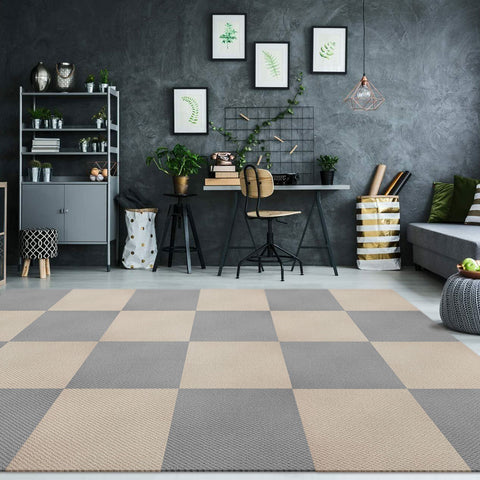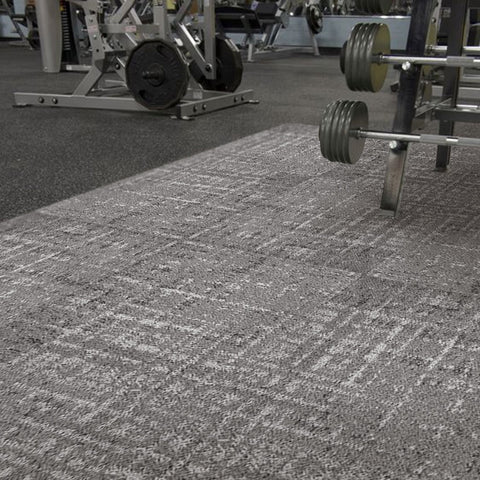Available for purchase in the USA
US

Carpet tiles, once a staple of office buildings and commercial spaces, have seen a surge in popularity for residential use. This versatile flooring option offers a myriad of design possibilities, durability, and ease of installation, making it an excellent choice for both homeowners and business operators alike. In this comprehensive guide, we'll explore the benefits of carpet tiles, delve into the various installation methods, offer maintenance tips, and showcase the wide range of design options available. Whether you're renovating your home or upgrading your office space, this guide will provide you with all the information you need to make an informed decision about carpet tiles.
Carpet tiles, also known as modular carpets or carpet squares, are precisely what their name suggests – square or rectangular tiles covered with carpeting. They range in size, but the most common dimensions are 18x18 inches or 24x24 inches, providing flexibility for various room sizes and shapes. Unlike traditional carpet rolls, these tiles are easier to handle, transport, and install.
The construction of carpet tiles is designed for durability and longevity. They consist of a carpet layer attached to a backing system. The materials used in their manufacturing include nylon, polypropylene, and recycled content, catering to the growing demand for eco-friendly options. Nylon is prized for its resilience and ability to retain color, making it ideal for high-traffic areas. Polypropylene offers a cost-effective alternative with good stain resistance, while recycled materials appeal to those looking for sustainable flooring solutions.

Carpet tiles are engineered to withstand the rigors of heavy foot traffic, making them an ideal choice for both commercial and residential settings. The unique aspect of carpet tiles lies in their ability to be easily replaced. Should a tile become stained or worn, it can be swapped out without having to replace the entire floor, ensuring your space always looks its best.
With an extensive array of textures, colors, and patterns available, carpet tiles offer unmatched versatility in design. Whether you're aiming for a bold, modern look or a subtle, classic feel, there's a carpet tile to fit every aesthetic. This flexibility also allows for custom designs and patterns, enabling creative expressions and zoning in open-plan spaces.
One of the most appealing aspects of carpet tiles is their ease of installation. They can be laid over various types of subfloors with minimal preparation, making them a convenient option for quick renovations. This DIY-friendly flooring solution does not require professional installation, saving time and labor costs.
The long-term savings associated with carpet tiles are significant. Their durability and the option to replace individual tiles rather than the entire floor contribute to their cost-effectiveness. This, combined with the ease of installation, makes carpet tiles a smart choice for those looking to maximize their flooring investment.
The first step in installing carpet tiles is to prepare the installation area. Ensure the subfloor is clean, dry, and level. Any irregularities in the subfloor can affect the appearance and longevity of the carpet tiles.
Before installation, plan your layout. This involves deciding on the direction of the tiles and determining if any need to be cut for edges and obstacles. Planning helps minimize waste and ensures a professional-looking finish.
Traditional carpet tiles require adhesive methods like glue-down or self-adhesive backings. However, innovations such as Matace Carpet Tiles have revolutionized the installation process. These tiles feature the Mecko backing system, which eliminates the need for glue. Instead, you simply peel off the protective film and place the tiles on the floor, significantly simplifying the installation process and making it cleaner and more user-friendly.
In some cases, tiles will need to be cut to fit around edges and obstacles. Use a sharp utility knife and a straight edge to make precise cuts, ensuring the tiles fit snugly and the overall appearance is neat and professional.
Maintaining carpet tiles is straightforward, ensuring their longevity and keeping them looking fresh. Here are essential tips for their upkeep:
Regular Cleaning:
Spot Cleaning:
Deep Cleaning:
Tile Replacement:

Carpet tiles offer unparalleled versatility in design, allowing for unique and dynamic flooring solutions.
When selecting carpet tiles for your space, several factors must be considered to ensure they meet your needs in terms of functionality, aesthetics, and longevity.
For those looking for high-quality, versatile carpet tiles, Matace Carpet Tiles stand out as an excellent choice. These tiles are crafted from 100% Polypropylene with a Mecko backing system, ensuring durability and ease of installation. The tiles are 19.69" x 19.69" in size, with a thickness of 0.33 inches and a pile weight of 17 oz/sq yd, making them ideal for medium traffic areas throughout the home.
Throughout this guide, we've explored the versatility, durability, and stylish appeal of carpet tiles, making them a compelling choice for any home project. From the ease of installation and maintenance to the vast array of design options available, carpet tiles offer a unique combination of functionality and aesthetic appeal.
As we've seen, Matace Carpet Tiles, with their innovative design and practical benefits, represent an excellent choice for those looking to enhance their living spaces. Their adaptability across various rooms, coupled with their user-friendly installation and maintenance features, underscores the appeal of carpet tiles as a flooring solution.
We encourage readers to consider carpet tiles for their next renovation project, embracing their potential to transform any space. Share this guide with friends and family considering a flooring update, or reach out to a flooring professional for more personalized advice on selecting and installing carpet tiles.
For further guidance on installing Matace Carpet Tiles, exploring design inspiration, or maintaining your new flooring, visit the following resources:
Leave a comment